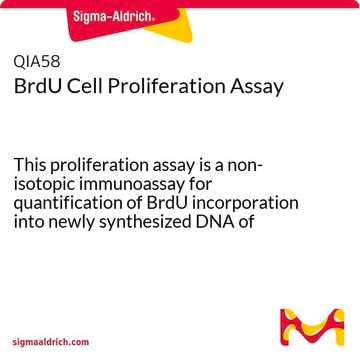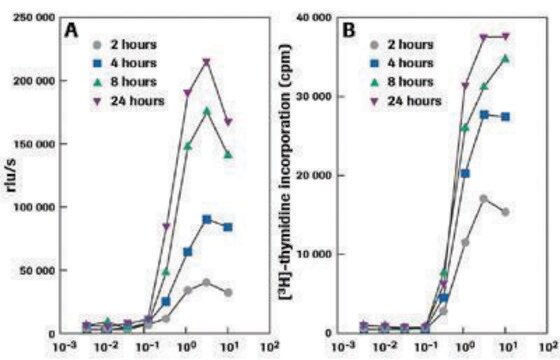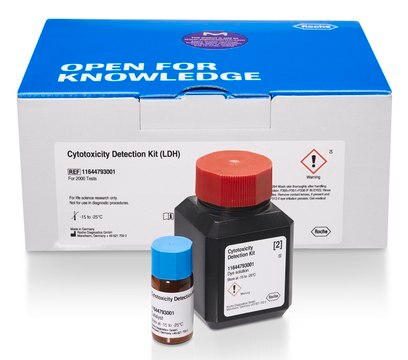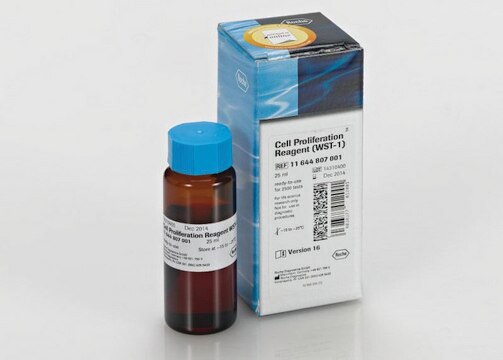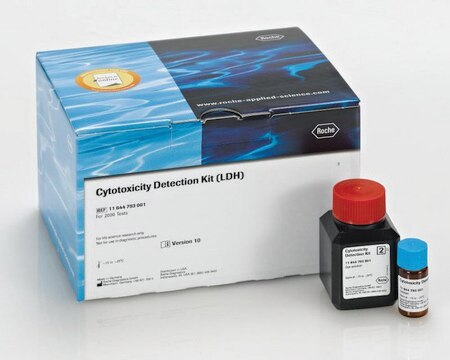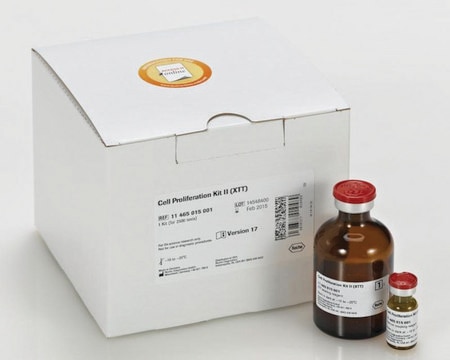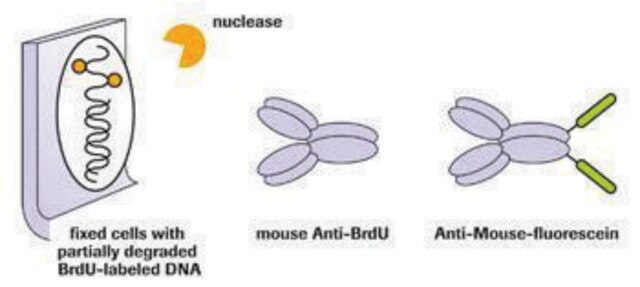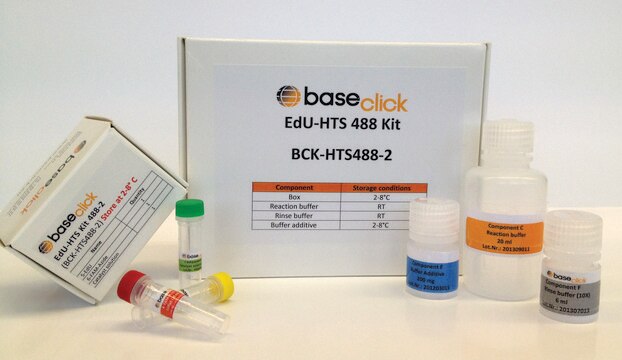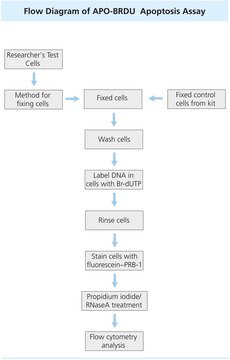11647229001
Roche
Cell Proliferation ELISA, BrdU (colorimetric)
sufficient for ≤1,000 tests
Synonym(s):
cell proliferation
About This Item
Recommended Products
usage
sufficient for ≤1,000 tests
Quality Level
manufacturer/tradename
Roche
technique(s)
ELISA: suitable
detection method
colorimetric
storage temp.
2-8°C
Related Categories
General description
Specificity
Application
The Cell Proliferation ELISA, BrdU (colorimetric) belongs to the second, improved generation of kits for measuring DNA synthesis. It is a precise, fast, and simple colorimetric alternative to quantitate cell proliferation based on the measurement of BrdU incorporation during DNA synthesis in replicating (cycling) cells. Thus, the Cell Proliferation ELISA can be used in many different in vitro cell systems. For example:
- Detection and quantification of cell proliferation induced by growth factors and cytokines
- Determination of the inhibitory or stimulatory effects of various compounds on cell proliferation in environmental and biomedical research, and in the food, cosmetic, and pharmaceutical industries
- Measurement of the immunoreactivity of lymphocytes, stimulated by mitogens or antigens
- Analysis of the chemosensitivity of tumor cells to different cytostatic drugs in medical research
- Testing of biocompatibility of various scaffolds, employed in bone tissue engineering, for bone cell growth
Packaging
Preparation Note
Working solution: BrdU labeling solution
Dilute BrdU labeling reagent 1:100 with sterile culture medium (resulting concentration: 100 μM BrdU).
For one 96-well MP, 1 ml BrdU labeling solution is required if the cells were cultured in 100 μl /well (10 μl/well) and 2 ml BrdU labeling solution is required if the cells were cultured in 200 μl/well (20 μl/well).
Anti-BrdU-peroxidase stock solution
Dissolve Anti-BrdU-peroxidase in 1.1 ml double-dist. water for 10 minutes and mix thoroughly.
Anti-BrdU-peroxidase working solution
Dilute Anti-BrdU-peroxidase stock solution 1:100 with antibody dilution solution. For one 96-well MP dilute 100 μl Anti-BrdU-peroxidase stock solution in 10 ml antibody dilution solution
Washing solution
Dilute Washing buffer concentrate 1:10 with double-dist. water.
For one 96-well MP dilute 10 ml Washing buffer concentrate with 90 ml double-dist. water.
Storage conditions (working solution): BrdU labeling solution
The undiluted BrdU labeling reagent (1000x): At 2 to 8 °C for several months protected from light.
The diluted BrdU labeling reagent: At 2 to 8 °C stable for several weeks. Store protected from light. For long-term storage it is recommended to store the BrdU labeling solution in aliquots at -15 to -25 °C.
Anti-BrdU-peroxidase stock solution
At 2 to 8 °C for several months. For long-term storage it is recommended to store the solution in aliquots at -15 to -25 °C.
Anti-BrdU-peroxidase working solution
Prepare shortly before use. Do not store.
Washing solution
At 2 to 8 °C for several weeks.
Reconstitution
Other Notes
Kit Components Only
- BrdU Labeling Reagent
- FixDenat ready-to-use
- Anti-BrdU-peroxidase antibody
- Antibody Dilution Solution ready-to-use
- Washing Buffer PBS 10x concentrated
- Substrate Solution TMB ready-to-use
Signal Word
Danger
Hazard Statements
Precautionary Statements
Hazard Classifications
Eye Irrit. 2 - Flam. Liq. 2 - Skin Sens. 1
Storage Class Code
3 - Flammable liquids
WGK
WGK 2
Certificates of Analysis (COA)
Search for Certificates of Analysis (COA) by entering the products Lot/Batch Number. Lot and Batch Numbers can be found on a product’s label following the words ‘Lot’ or ‘Batch’.
Already Own This Product?
Find documentation for the products that you have recently purchased in the Document Library.
Customers Also Viewed
Articles
Regulation of the cell cycle involves processes crucial to the survival of a cell, including the detection and repair of genetic damage as well as the prevention of uncontrolled cell division associated with cancer. The cell cycle is a four-stage process in which the cell 1) increases in size (G1-stage), 2) copies its DNA (synthesis, S-stage), 3) prepares to divide (G2-stage), and 4) divides (mitosis, M-stage). Due to their anionic nature, nucleoside triphosphates (NTPs), the building blocks of both RNA and DNA, do not permeate cell membranes.
Cell based assays for cell proliferation (BrdU, MTT, WST1), cell viability and cytotoxicity experiments for applications in cancer, neuroscience and stem cell research.
Protocols
Cell Proliferation ELISA, BrdU (colorimetric) Protocol & Troubleshooting
Our team of scientists has experience in all areas of research including Life Science, Material Science, Chemical Synthesis, Chromatography, Analytical and many others.
Contact Technical Service